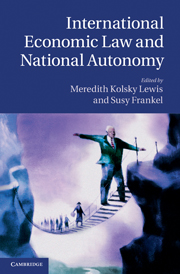Book contents
- Frontmatter
- Contents
- Notes on contributors
- Acknowledgements
- Introduction
- PART I International economic law: conceptions of convergence and divergence
- PART II WTO treaty interpretation: implications and consequences
- PART III Responding to international economic law commitments
- 8 Safety standards and indigenous products: what role for traditional knowledge?
- 9 The GATS and temporary migration policy
- 10 A different approach to the external trade requirement of GATT Article XXIV: assessing ‘other regulations of commerce’ in the context of EU enlargement and its heightened regulatory standards
- PART IV Transformations in international economic law
- Index
- References
9 - The GATS and temporary migration policy
from PART III - Responding to international economic law commitments
Published online by Cambridge University Press: 10 January 2011
- Frontmatter
- Contents
- Notes on contributors
- Acknowledgements
- Introduction
- PART I International economic law: conceptions of convergence and divergence
- PART II WTO treaty interpretation: implications and consequences
- PART III Responding to international economic law commitments
- 8 Safety standards and indigenous products: what role for traditional knowledge?
- 9 The GATS and temporary migration policy
- 10 A different approach to the external trade requirement of GATT Article XXIV: assessing ‘other regulations of commerce’ in the context of EU enlargement and its heightened regulatory standards
- PART IV Transformations in international economic law
- Index
- References
Summary
Introduction
This chapter addresses the General Agreement on Trade in Services (GATS) in relation to temporary migration policy. It is argued that Mode 4 of the GATS remains essentially subject to strict domestic regulations and limitations. Yet, many countries accept the importance of temporary migration as a necessary element to become more competitive in a knowledge-based society. In the European Union (EU), for example, a new global approach is needed so that migration strikes the right balance amidst the risk of labour market shortages, economic impacts, negative social consequences, integration policies and external policy objectives. Moreover, the changing demands of an ageing society and a labour market in constant evolution have challenged established assumptions about migration from outside the EU. Therefore, it is argued that the EU needs more temporary migration from an economic point of view.
The movement of people has increased markedly in recent decades, with international migration doubling since 1975. However, migration patterns today are very different from those in previous cycles of globalisation. Temporary migration, which is often work-related, has increased across the Organisation for Economic Cooperation and Development (OECD) countries over the past two decades, and migration of highly-skilled people has also become much more common. As competitiveness is increasingly shaped by a country's ability to attract and retain a skilled workforce, competition among countries for highly-skilled workers is likely to continue to increase.
- Type
- Chapter
- Information
- International Economic Law and National Autonomy , pp. 193 - 215Publisher: Cambridge University PressPrint publication year: 2010
References
- 1
- Cited by



